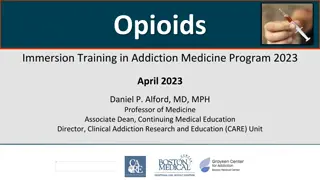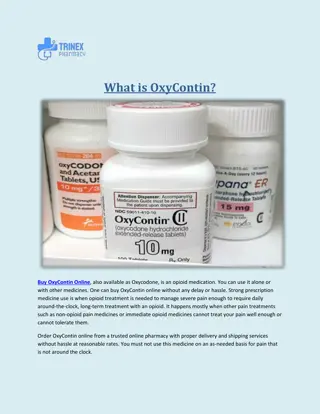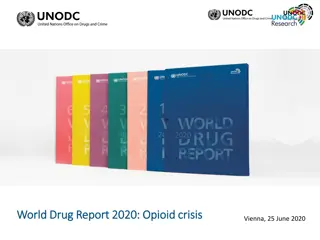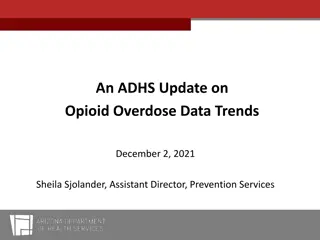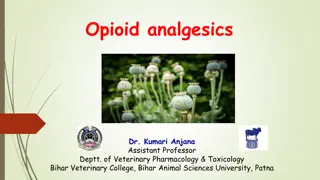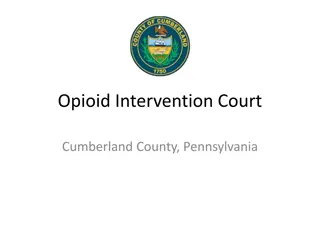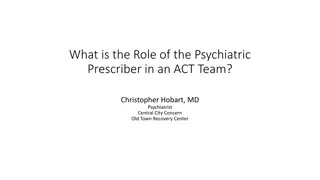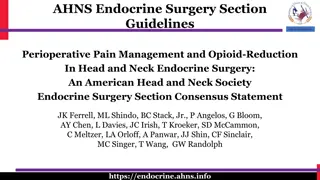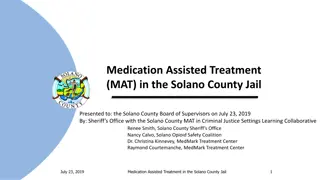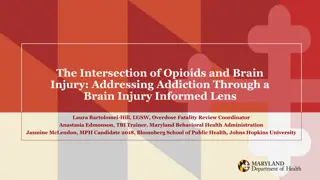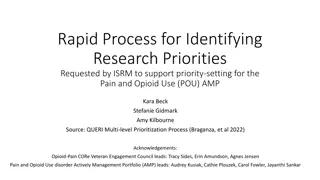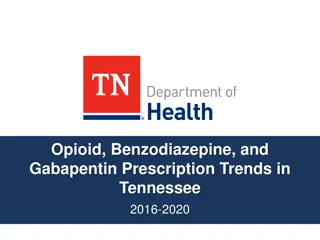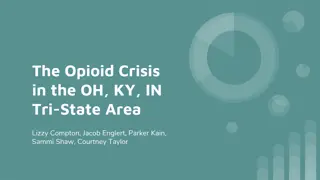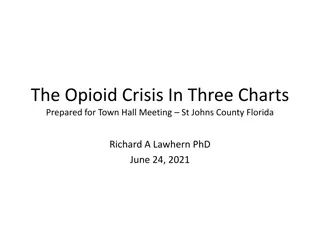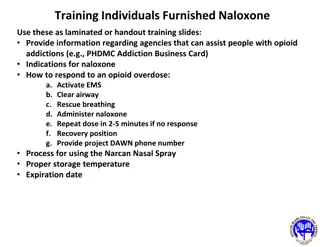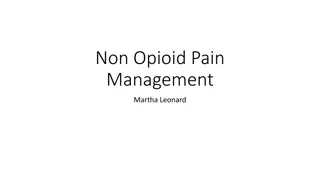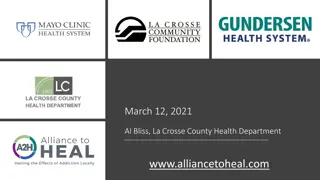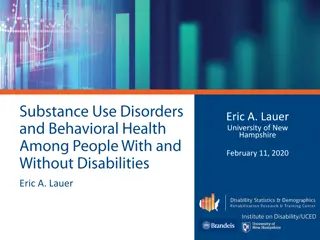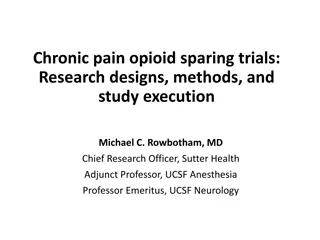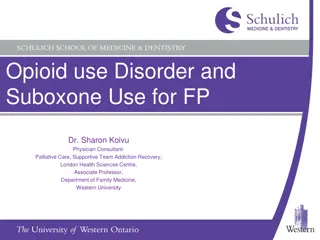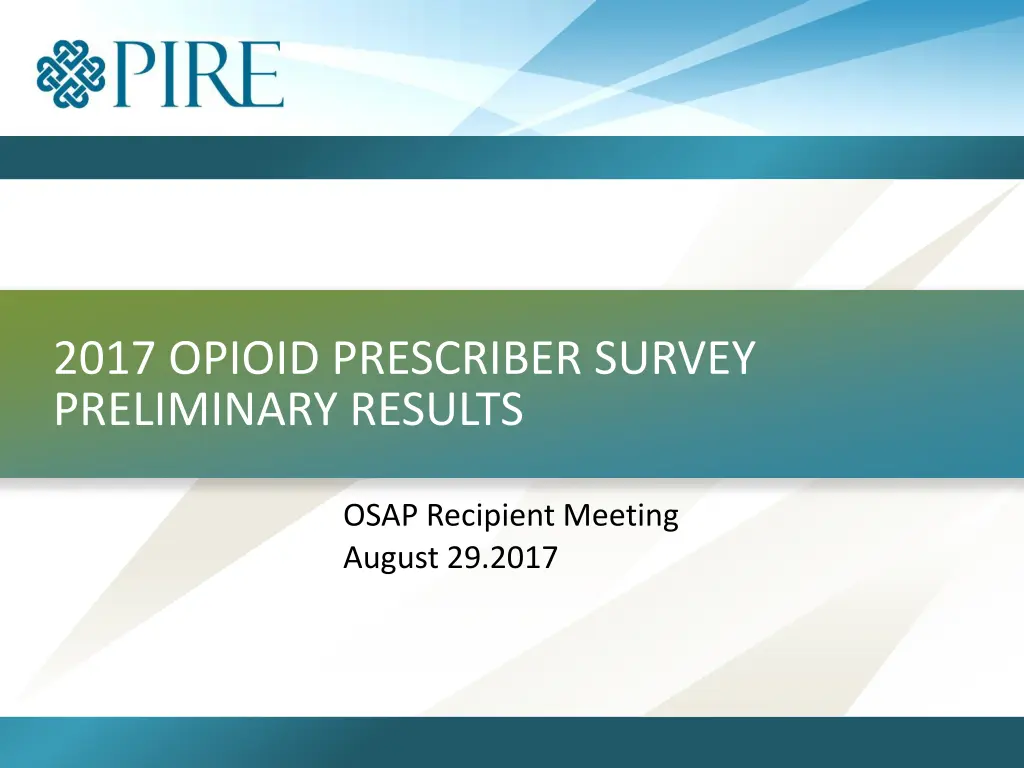
Opioid Prescriber Survey 2017 Preliminary Results Analysis
Explore the findings from the 2017 Opioid Prescriber Survey, including respondent demographics, concerns about over-prescribing opioids, and approaches to pain management. Gain insights into the perspectives of healthcare providers on opioid prescribing practices.
Download Presentation

Please find below an Image/Link to download the presentation.
The content on the website is provided AS IS for your information and personal use only. It may not be sold, licensed, or shared on other websites without obtaining consent from the author. If you encounter any issues during the download, it is possible that the publisher has removed the file from their server.
You are allowed to download the files provided on this website for personal or commercial use, subject to the condition that they are used lawfully. All files are the property of their respective owners.
The content on the website is provided AS IS for your information and personal use only. It may not be sold, licensed, or shared on other websites without obtaining consent from the author.
E N D
Presentation Transcript
2017 OPIOID PRESCRIBER SURVEY PRELIMINARY RESULTS OSAP Recipient Meeting August 29.2017
METHODS 9,485 email invitations went out PMP registered users Completed survey on-line 1,672 responses 1,380 prescribe opioids and/or benzos in their practice 18% response rate (very conservative estimate since we couldn t weed out people who don t prescribe opioids from the beginning and not invite them; a lot of retired prescribers and now out of state prescribers)
SAMPLE CHARACTERISTICS Every county was represented 46.3% practiced in Bernalillo County Average number of years in practice 18.9 years 85.8% report providing opioids and/or benzodiazepines 84% report being required to use the PMP
MEDICAL PRACTICE OF RESPONDERS (N= 1649) 30.0 24.1 25.0 23.1 22.6 20.0 Percent 15.0 9.9 10.0 7.8 6.9 4.0 5.0 1.0 0.6 0.2 0.0 Pharmacist (Pharm D) Nurse Practitioner Dentist (DMD) Oral Surgeon (DDS) Physician Assistant (PA) Primary Care Physician (MDs & DOs) Podiatrist (DPM) Surgeon Specialty Provider, MD (E.g., orthopedics, oncology, etc.) Other
GENDER OF RESPONDENTS (N= 1646) Male 2.3, 2% 0.1 Female 46.4 51.2 I choose not to identify Other (please specify)
TO WHAT EXTENT ARE YOU WORRIED ABOUT THE OVER PRESCRIBING OF OPIOIDS TO PATIENTS IN GENERAL? (N= 1155) Not worried at all. This is just an over reaction. 1.2% 8.8% Somewhat worried, but it's not as bad as the news makes it out to be. 35.6% Worried. Prescribers need to be careful when prescribing opioids to patients. 54.4% Very worried. Too many people are being prescribed opioid painkillers who don't need them for pain.
DURING AN AVERAGE WORK WEEK, ABOUT HOW OFTEN ARE YOU ASKED TO ADDRESS A PATIENT'S PAIN MANAGEMENT CONCERNS? (N=1151) One to two times a week 30.4%, 41.9%, Several times a week Every day 27.7%,
APPROACHES TO TREATING PAIN Percent Somewhat unlikely Somewhat likely Very likely Prescriber Approaches Very unlikely If a patient presents with pain concerns, how likely are you to suggest an over-the-counter pain medication such as ibuprofen or acetaminophen as the first option? (n=1149) If a patient presents with pain concerns, how likely are you to prescribe an opioid painkiller as the first option? (n=1144) If a patient presents with pain concerns, how likely are you to suggest alternative pain management (i.e., physical therapy) before prescribing opioids? (n=1143) 5.0 2.5 11.7 80.9 71.4 20.2 5.5 2.9 7.2 7.7 18.5 66.6
DO YOU EVER PRESCRIBE METHADONE FOR PAIN? (N= 1142) 12.2% Yes No 87.8%
IN THE CONTEXT OF YOUR PRACTICE, WHEN FIRST PRESCRIBING OPIOIDS TO A PATIENT, HOW OFTEN DO YOU Percent In the context of your practice, when first prescribing opioids to a patient, how often do you Somewhat often Hardly ever Often Always ... inquire about the patient s past opioid use (illicit and/or licit)? (n=1113) ... inquire about any past problems the patient may have with substance use or addiction? (n=1113) 7.7 10.7 25.6 56.0 10.1 15.4 24.3 50.2 ... use an assessment tool to screen for any past or potential problems with a substance use disorder? (n=1113) 52.4 16.6 14.4 16.6 ... review the patient's chart for previous opioid or benzodiazepine prescriptions prior to prescribing an opioid? (n=1113) 3.1 4.0 19.5 73.3 ... avoid prescribing opioid pain medication for patients receiving benzodiazepines when possible? (n=1113) ... check the Prescription Drug Monitoring data base for previous opioid prescriptions given to the patient prior to prescribing an opioid? (n=1113) 4.2 11.1 30.9 53.7 12.0 10.7 26.9 50.4 57.5 8.7 15.5 18.3 ... ask a delegate to pull/run a PMP report on a patient? (n=1113) ... ask a delegate to review the PMP report and let you know if there are concerns? (n=1113) 70.8 7.7 10.3 11.1 47.8 14.2 19.6 18.4 ... require a urine test prior to prescribing opioids? (n=1113) ... provide a prescription for naloxone/Narcan at the same time? (n=1110) 75.9 10.7 8.1 5.2
IN GENERAL, TO WHAT EXTENT ARE YOU CONCERNED ABOUT THE ABUSE OF OPIOIDS IN YOUR PATIENTS? (N= 1113) 5.8% 12.3% Very unconcerned 42.7% Somewhat unconcerned Somewhat concerned Very concerned 39.3%
WHEN PRESCRIBING OPIOIDS, HOW LIKELY ARE YOU PERSONALLY TO TALK TO YOUR PATIENTS ABOUT THE FOLLOWING (N=1096) Percent Very unlikely Somewhat unlikely Somewhat likely Very likely Proper disposal of unused/expired medication (especially opioids). Safe storage of prescription drugs (especially opioids) at home. The dangers of mixing prescription drugs (especially opioids) with alcohol and other drugs (e.g., benzodiazepines). The dangers of sharing prescriptions with other people to whom they are not prescribed (especially opioids). How to recognize the signs of addiction (especially with opioids). How to use naloxone/Narcan to prevent accidental overdose. 21.4 20.3 28.3 29.9 14.7 13.0 26.0 46.4 4.1 4.2 17.5 74.2 11.4 9.4 21.1 58.1 16.7 21.6 29.2 32.5 45.0 22.9 18.7 13.4
PERCENT OF PRESCRIBERS WHO HAVE OTHERS EDUCATE 27.5 20.5 Percent 18.9 18.6 15.5 14.0 Proper disposal of unused/expired medication (especially opioids) Safe storage of prescription drugs (especially opioids) at home The dangers of mixing prescription drugs (especially opioids) with alcohol and other drugs (e.g., benzodiazepines) The dangers of sharing prescriptions with other people to whom they are not prescribed (especially opioids) How to recognize the signs of addiction (especially with opioids) How to use naloxone/Narcan to prevent accidental overdose
TO WHAT EXTENT ARE YOU AWARE OF THE NEW REGULATIONS REGARDING USE OF THE PMP IN NEW MEXICO THAT WENT INTO EFFECT IN JANUARY 2017 (SB 263)? (N= 1095) 2.6% 8.8% I've heard nothing about it Vaguely aware 45.0% Somewhat aware I know all about it 43.6%
TO WHAT EXTENT ARE YOU COMPLIANT WITH THE NEW REGULATIONS REGARDING USE OF THE PMP IN NEW MEXICO THAT WENT INTO EFFECT IN JANUARY 2017 (SB 263)? (N= 1066) 0.7% 24.6% Not at all compliant Somewhat compliant Very compliant 74.8%
HAVE YOUR PRESCRIBING PRACTICES CHANGED OVER THE LAST 12 MONTHS? (N=1093) 14.2% 24.3% Not at all Some Very much 26.9%
DO YOU THINK ABOUT/DISCUSS AN EXIT STRATEGY WHEN STARTING A PATIENT ON AN OPIOID? 36% Yes No 64%
WHEN DISCONTINUING A PATIENT'S LONG-TERM OPIOID PRESCRIPTION (I.E., OVER 30 DAYS), HOW LIKELY ARE YOU TO DISCUSS AN EXIT STRATEGY WITH THE PATIENT? (N= 1092) 60.0% 50.4% 50.0% 40.0% 30.0% 19.0% 17.6% 20.0% 9.6% 10.0% 3.4% 0.0% Very unlikely Somewhat unlikely Neither likely nor unlikely Somewhat likely Very likely
WOULD YOU LIKE FURTHER EDUCATION ON EFFECTIVE EXIT STRATEGIES? (N= 1087) No Yes 44% 56%
DOES YOUR PRACTICE HAVE A CURRENT POLICY OR PROTOCOL FOR PRESCRIBING PRESCRIPTION PAINKILLERS TO PATIENTS? (N= 1111) 32.4% No Yes 67.6%
IN YOUR OPINION, HOW WELL DO YOU ADHERE TO THE POLICY OR PROTOCOL? (N= 748) Strictly adhere 65.4 Mostly adhere 33.7 Sometimes adhere 0.7 Do not adhere at all 0.3 0 10 20 30 40 50 60 70 Percent
EFFECTIVENESS OF OPIOID PRESCRIBING POLICIES Percent Very Mostly ineffective Mostly effective Very effective ineffective How effective is the current policy or protocol at your practice in protecting doctors from over prescribing Rx pain killers? (n=747) How effective is the current policy or protocol at your practice in preventing patients from abusing Rx pain killers? (n=746) 1.7 8.0 53.4 36.8 3.2 15.5 57.8 23.5

